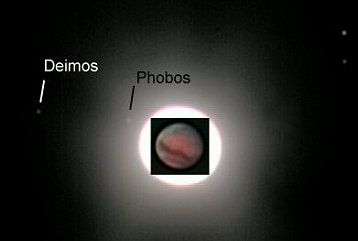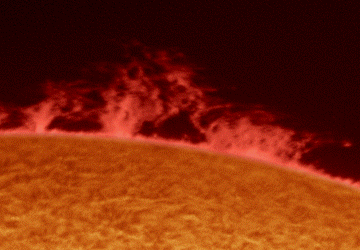 Would you like a call when the space station orbits over your backyard? Sign up for SpaceWeather PHONE.
Would you like a call when the space station orbits over your backyard? Sign up for SpaceWeather PHONE.
QUIET SUN: Solar activity is very low. Solar flares and auroras are unlikely this week.
FEAR AND PANIC: The two moons of Mars, Phobos and Deimos (Greek for Fear and Panic), are easy to overlook. They're tiny, less than 22 km wide, dim and rarely seen through a telescope. Mars itself shines 242,000 times brighter than Phobos and 741,000 times brighter than Deimos. The two moons get lost in the glare.
Nevertheless, it is possible, with effort, to photograph Phobos and Deimos. Steve Bodin of Mattawa, Washington, did it on October 10th:

"This is a composite of two exposures: a short exposure for Mars and a longer one to capture the faint moons," says Bodin, who used a 16-inch telescope and a color video camera. "Note the two 12th-magnitude stars visible to the upper right of Mars."
DANCING PROMINENCE: Who says solar activity is low? This morning in Germany, Stefan Seip photographed a solar prominence, and he swears he saw a dancer among the fiery plumes:

Staring at prominences on the sun is a bit like staring at clouds on Earth: with enough imagination, you can see all sorts of fantastic shapes. In fact, solar prominences are clouds. Unlike Earth-clouds, however, which tend to be cold and watery, solar clouds are hot and made mostly of hydrogen. This cloudy prominence will likely persist for another day or so. What shape will it be tomorrow?
more images: from Andreas Murner of Lake Chiemsee, Bavaria, Germany;

